Sound and Music
Computing '04 Improvisation With Computer Workshop
 Wednesday,
October 20, 2004
Wednesday,
October 20, 2004
02:00 pm - 06:15pm and 08:00 pm - 12:00 pm
IRCAM, Espace de projection. Access conditions: by registration
only. Fees: included in the SMC fee, or 30 Euros if purchased
apart. Simultaneous translation from English to French. Organized
in collaboration with the Electronic Music Foundation as part
of its 10th anniversary.
This workshop is dedicated to the interaction between man and
machine inside an improvisational context. Beyond simple sound
effects and the immediate processing of sound signals produced
by the musician, now rather uninspiring, these presentations aim
to focus on a modeling of musical structure and an interaction
of the musician with this model. As such, can the computer expand
the musical field and by entering into an exchange with the musician,
create surprises within a controlled framework? Each hour-long
session will address a musical/technological problem using sound
illustrations followed by the live performance of an artist specialized
in improvisation, putting into practice the systems presented.
It is important to point out that the main topic of the workshop
is not the technical complexity of the computer systems presented,
but the fitting of these computer environments, whatever they
be simple or complex, to the musical improvisation project associated
with them.
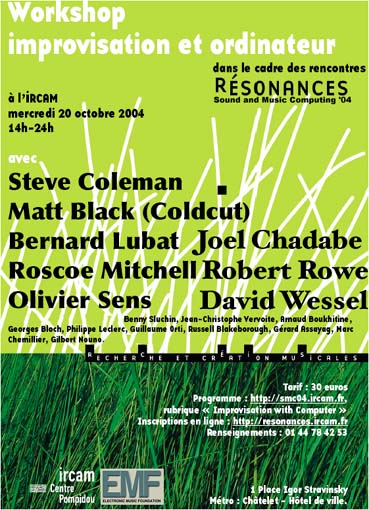
Schedule
14:00
Joel Chadabe (composer, President, Electronic Music Foundation)
14:45
Robert Rowe (composer, Associate Director of the Music
Technology Program, New York University)
15:30
Benny Sluchin (tromboniste/trombonist, Ensemble Intercontemporain)
Jean-Christophe Vervoite (cor/French horn, Ensemble Intercontemporain)
Arnaud Boukhitine (tuba/tuba, Ensemble Intercontemporain)
16:15 Pause café/Coffee break
16:45
Olivier Sens (contrebassiste/bass player, chercheur/researcher)
Guillaume Orti (saxophoniste/saxophonist)
17:30
Gérard Assayag (chercheur/researcher, Ircam)
Marc Chemillier (chercheur/researcher, Ircam)
Georges Bloch (compositeur/composer, chercheur/researcher)
Philippe Leclerc (saxophoniste/saxophonist)
18:15 Pause dîner/Diner break
20:00
Bernard Lubat (multi-instrumentiste/multi-instrumentalist)
20:45
Steve Coleman (saxophoniste/saxophonist, chercheur/researcher)
Gilbert Nouno (chercheur/researcher, Ircam)
21:30 Break
22:00
Roscoe Mitchell (saxophoniste/saxophonist, Art Ensemble
of Chicago)
David Wessel (compositeur/composer, Director, CNMAT, University
of California at Berkeley)
22:45
Matt Black (Coldcut/Ninjatune)
Russell Blakeborough (VJamm/Headspace)
Details
Joel Chadabe (composer, President, Electronic Music Foundation)
The opening lecture by Joel Chadabe, author of the stimulating
book Electric Sound, will present with images and sounds the history
of interactivity with computers. Using a Kyma DSP system, he will
also present a 10-minute performance with a flutist of one of
the interactive compositions from his newly released CD 'Many
Times ...''
 Joel Chadabe
Joel Chadabe
Robert Rowe (composer, Associate Director of the Music
Technology Program, New York University)
Robert Rowe has published two books that discuss interactive
improvisation: Interactive Music Systems (MIT Press 1993; published
in French as Systèmes musicaux intéractifs, Thomson
International 1996) and Machine Musicianship (MIT Press 2001).
This talk will present the Cypher improvisation system, as well
as more recent work, in which real-time algorithmic music analysis
is used to generate an improvised response that is related to
the musical structures found. Recorded examples and a live demonstration
will show the responsiveness of the system.
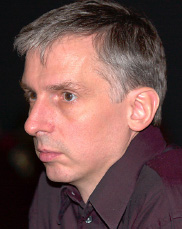 Robert Rowe
Robert Rowe
Benny Sluchin (tromboniste/trombonist, Ensemble Intercontemporain)
Jean-Christophe Vervoite (cor/French horn, Ensemble Intercontemporain)
Arnaud Boukhitine (tuba/tuba, Ensemble Intercontemporain)
The piece Linaia Agon by Xenakis (1972) is a fight between
Linos (trombone) and Apollon (tuba or French horn), in which the
scheduling of the events is in some sense improvised. The order
of the musical sequences to be played is not fixed, but is left
to a random process derived from the games theory. For each couple
of sequences played by Linos and Apollon, a matrix gives the number
of points won by one and lost by the other. A computer screen
displays the current state of the random process and the points
of each player. Benny Sluchin will explain how the piece works,
and then the piece will be played.
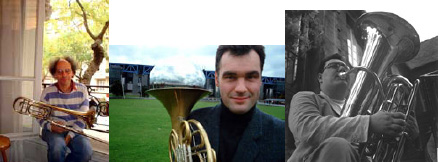 Benny Sluchin, Jean-Christophe Vervoite , Arnaud
Boukhitine
Benny Sluchin, Jean-Christophe Vervoite , Arnaud
Boukhitine
Olivier Sens (contrebassiste/bass player, chercheur/researcher)
Guillaume Orti (saxophoniste/saxophonist)
Olivier Sens has designed the software Usine, in order to interact
in a live performance context with saxophonist Guillaume Orti.
His system allows one to follow any audio instrumental source,
by detecting in real time particular parameters of the audio stream.
Their performance during the workshop will be at the crossroad
between jazz and electronic music, an area explored by many young
French jazz musicians, in particular from the Collectif Hask or
the ZAM.
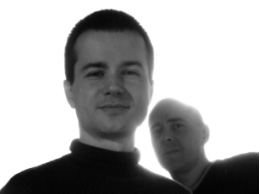
Guillaume Orti & Olivier Sens
Gérard Assayag (chercheur/researcher, Ircam)
Marc Chemillier (chercheur/researcher, Ircam)
Georges Bloch (compositeur/composer, chercheur/researcher)
Philippe Leclerc (saxophoniste/saxophonist)
The improvisation software Omax designed at Ircam by Gérard
Assayag and Marc Chemillier (based on Max and OpenMusic) allows
one to generate phrases in the style of those played by a musician
(with or without a regular beat), and to associate automatically
generated chord sequences to them. The Ofon system designed by
Georges Bloch extends the possibilities of Omax in order to deal
with audio recordings. The phrases played by the musician are
recorded, then pitches are extracted, and the data are inserted
into an automaton which generates new phrases by recombining the
recorded ones, the sound being produced directly by reading the
original audio files.
 PhilippeLeclerc
PhilippeLeclerc
20:00
Bernard Lubat (multi-instrumentiste/multi-instrumentalist)
Bernard Lubat will interact with the Omax software developed by
Gérard Assayag and Marc Chemillier. In this confrontation
between the man and the machine, conceived as a challenge, the
improvisation process consists in exploring the limits of the
machine. In a way similar to a rugby match, each player has prepared
everything (man or machine), but he has to adapt his playing to
the reactions of the adversary.
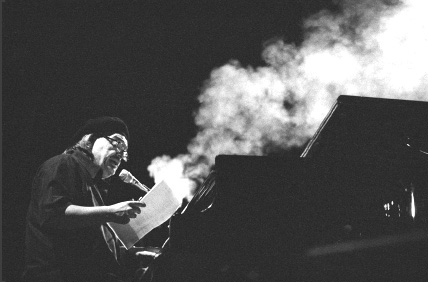 Bernard Lubat (Photo © Gérard Blot)
Bernard Lubat (Photo © Gérard Blot)
Steve Coleman (saxophoniste/saxophonist, chercheur/researcher)
Gilbert Nouno (chercheur/researcher, Ircam)
Steve Coleman is one of the few jazz musicians who has developed
his own ideas about interactive computer software. Four years
ago, he presented his Rameses 2000 computer software program in
Paris, as the result of a commission he received from Ircam. He
will further develop these ideas into small independent modules,
in collaboration with researcher Gilbert Nouno. Each module will
be loaded as a demonstration of a particular process as follows:
Mono Concepts (Rhythm, Melody, Harmony), Duo Concepts (Rhythm
+ Melody, Rhythm + Harmony, Melody + Harmony), Trio Concept (Rhythm
+ Melody + Harmony). Steve Coleman will discuss further aspects
of these concepts involving astronomical, astrological, divinatory
and mythological considerations.
 Steve Coleman & Gilbert Nouno, Ircam (Photo
© Eve-Marie Breglia)
Steve Coleman & Gilbert Nouno, Ircam (Photo
© Eve-Marie Breglia)
Roscoe Mitchell (saxophoniste/saxophonist, Art Ensemble
of Chicago)
David Wessel (compositeur/composer, Director, CNMAT, University
of California at Berkeley)
Roscoe Mitchell, a major figure from the jazz scene during
the last forty years, has been interested in improvisation with
the computer for a long time. His collaboration with David Wessel,
another pioneer of the field, has given birth to the creation
in 1986 at Ircam of the piece Contacts Turbulents, for saxophone
and electronics. Roscoe Mitchell's alto saxophone will be dissecting
with microsurgical precision the interaction process between the
improvisor and the computer.

Roscoe Mitchell (Photo © Dario Guerini)
Matt Black (Coldcut/Ninjatune)
Russell Blakeborough (VJamm/Headspace)
Matt Black and Russell Blakeborough will show how to use the
computer in a live audiovisual (AV) context. Matt of Coldcut is
the designer of the VJamm software, coded by Russell and Camart;
VJamm can be viewed as an instrument to play with AV samples.
It introduces a new improvisation dimension of rhythmic AV collage,
constructed in realtime, with the sound and visuals perfectly
in sync. "What you see is what you hear". This is possible
with the very fast response of the program, and the real time
editing functions like speed change, reverse, loop, keying and
a battery of Freeframe effects plugins. VJamm is fully MIDI controllable.
The pair will present Freeframe and VJamm, and then make a performance
using these instruments with short, AV clips to create a collage
in the vein of the famous Coldcut/Hexstatic video Timber.

Coldcut concert, September 2001
Grande salle Centre Pompidou (© Bertrand Prévost 2002)
 Wednesday,
October 20, 2004
Wednesday,
October 20, 2004
 Joel Chadabe
Joel Chadabe Robert Rowe
Robert Rowe

 PhilippeLeclerc
PhilippeLeclerc


